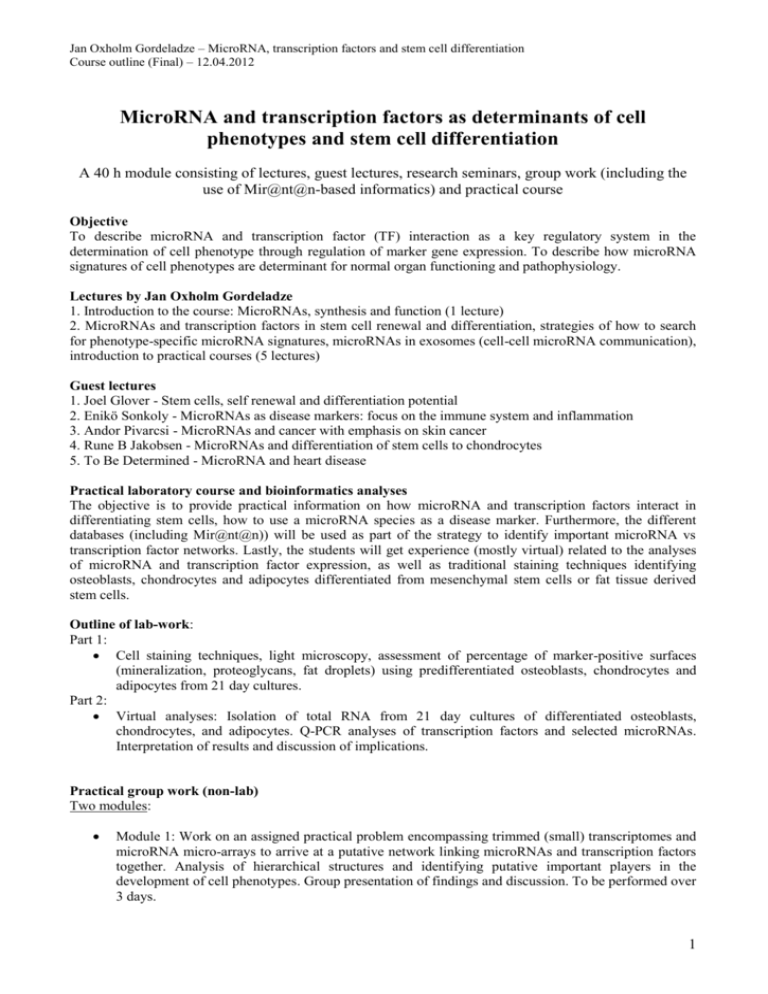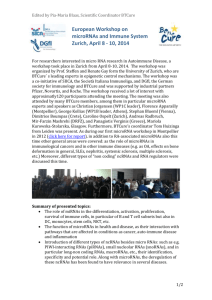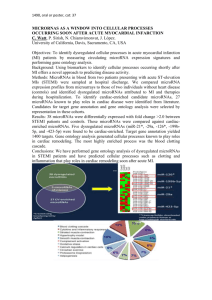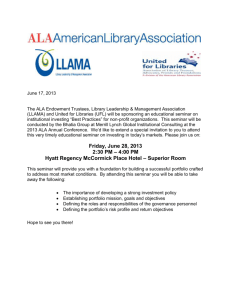Epigenetics, development and disease
advertisement

Jan Oxholm Gordeladze – MicroRNA, transcription factors and stem cell differentiation Course outline (Final) – 12.04.2012 MicroRNA and transcription factors as determinants of cell phenotypes and stem cell differentiation A 40 h module consisting of lectures, guest lectures, research seminars, group work (including the use of Mir@nt@n-based informatics) and practical course Objective To describe microRNA and transcription factor (TF) interaction as a key regulatory system in the determination of cell phenotype through regulation of marker gene expression. To describe how microRNA signatures of cell phenotypes are determinant for normal organ functioning and pathophysiology. Lectures by Jan Oxholm Gordeladze 1. Introduction to the course: MicroRNAs, synthesis and function (1 lecture) 2. MicroRNAs and transcription factors in stem cell renewal and differentiation, strategies of how to search for phenotype-specific microRNA signatures, microRNAs in exosomes (cell-cell microRNA communication), introduction to practical courses (5 lectures) Guest lectures 1. Joel Glover - Stem cells, self renewal and differentiation potential 2. Enikö Sonkoly - MicroRNAs as disease markers: focus on the immune system and inflammation 3. Andor Pivarcsi - MicroRNAs and cancer with emphasis on skin cancer 4. Rune B Jakobsen - MicroRNAs and differentiation of stem cells to chondrocytes 5. To Be Determined - MicroRNA and heart disease Practical laboratory course and bioinformatics analyses The objective is to provide practical information on how microRNA and transcription factors interact in differentiating stem cells, how to use a microRNA species as a disease marker. Furthermore, the different databases (including Mir@nt@n)) will be used as part of the strategy to identify important microRNA vs transcription factor networks. Lastly, the students will get experience (mostly virtual) related to the analyses of microRNA and transcription factor expression, as well as traditional staining techniques identifying osteoblasts, chondrocytes and adipocytes differentiated from mesenchymal stem cells or fat tissue derived stem cells. Outline of lab-work: Part 1: Cell staining techniques, light microscopy, assessment of percentage of marker-positive surfaces (mineralization, proteoglycans, fat droplets) using predifferentiated osteoblasts, chondrocytes and adipocytes from 21 day cultures. Part 2: Virtual analyses: Isolation of total RNA from 21 day cultures of differentiated osteoblasts, chondrocytes, and adipocytes. Q-PCR analyses of transcription factors and selected microRNAs. Interpretation of results and discussion of implications. Practical group work (non-lab) Two modules: Module 1: Work on an assigned practical problem encompassing trimmed (small) transcriptomes and microRNA micro-arrays to arrive at a putative network linking microRNAs and transcription factors together. Analysis of hierarchical structures and identifying putative important players in the development of cell phenotypes. Group presentation of findings and discussion. To be performed over 3 days. 1 Jan Oxholm Gordeladze – MicroRNA, transcription factors and stem cell differentiation Course outline (Final) – 12.04.2012 Module 2: Journal club - to analyze and present orally one relevant publication chosen from an assigned list using the paper to shed light on experimental findings. The PhD-students will work in groups of 2-4 (depending on how many groups). Tentative course schedule Monday 09.00-11.00 - Seminar Room 2240 (Domus Medica, Dept. of Biochemistry) Stem cells, self renewal and differentiation potential (Lecturer 1 - Dr. J. Glover, Institute of Physiology, Inst. of Basic Medical Science, University of Oslo, Norway) Introduction to course: MicroRNA, synthesis and function (Dr. Jan Oxholm Gordeladze, Dept. of Biochemistry, Inst. of Basic medical Science, University of Oslo, Norway = JOG) 11.00-12.00 - Seminar Room 2240 (Domus Medica, Dept. of Biochemistry) MicroRNAs and transcription factors in stem cell renewal (JOG) 12.00-13.00 Lunch break (no seminar) 13.00-17.00 - Seminar Room 2180 (Domus Medica, Dept. Nutritional Science) Literature studies (literature package), assigned reading Tuesday 09.00-11.00 - Seminar Room 1151 (Domus Medica, Inst. of Basic Med. Science) MicroRNAs and differentiation of stem cells to chondrocytes (Lecturer 4 - PhD-student, MD Rune B Jakobsen, Avd. For Biokjemi, Stamcelleepigenetikk) MicroRNAs and heart disease (Lecturer 5 - To be determined) 11.00-12.00 - Seminar Room 2183 (Domus Medica, Dept. of Biochemistry) Prepare for lab work, cell staining techniques (intro by JOG) 12.00-13.00 Lunch break (no seminar) 13.00-19.00 - Laboratory GA01 1123 or Seminar Room To Be Determined (Domus Medica) Cell staining, light microscopy, qualitative assessment of percentage of marker-positive cells/cell surfaces (MSCs differentiated to osteoblasts, chondrocytes and adipocytes) How to study microRNAs in stem cell differentiation: Strategies, general approach (JOG) Literature studies (literature package), assigned tasks Wednesday 09.00-11.00 - Seminar Room 2240 (Domus Medica, Dept. of Biochemistry) How to search for phenotype-specific microRNA signatures (JOG): specific approach 11.00-13.00 - Seminar Room 3100 (Domus Medica, Dept. Nutritional Science) Seminar 1 (during lunch) on cell staining and literature studies (PhD students) 13.00-19.00 - Seminar Room 2180 (Domus Medica, Dept. Nutritional Science) Use of bioinformatics to create regulatory networks linking microRNAs, transcription factors and phenotypic marker genes (Lecture by JOG and practical work = bioinformatics) 2 Jan Oxholm Gordeladze – MicroRNA, transcription factors and stem cell differentiation Course outline (Final) – 12.04.2012 Thursday 09.00-12.00 - Seminar Room 1151 (Domus Medica, Inst. of Basic Med. Science) MicroRNAs as disease markers: focus on the immune system and inflammation (Lecturer 2 - Dr. Enikö Sonkoly, Molecular Dermatology Research Group, Unit of Derma-tology and Venerology, Center for Molecular Medicine, Karolinska Institutet, Stockholm, Sweden) MicroRNAs and cancer - Emphasis on skin cancer (Lecturer 3 - Dr. Andor Pivarcsi, Molecular Dermatology Research Group, Unit of Dermatology and Venerology, Center for Molecular Medicine, Karolinska Institutet, Stockholm, Sweden) Cell-to-cell communication through microRNAs in exosomes: Implications for cell engineering (JOG) 12.00-13.00 - Seminar Room 2180 (Domus Medica, Dept. Nutritional Science) Lunch break 13.00-17.00 - Seminar Room 2180 (Domus Medica, Dept. Nutritional Science) Practical course: Analyze transcription factors and selected microRNA species in virtual samples of total RNA from differentiated mesenchymal stem cells (MSCs) and adipose stem cells (ASCs) Literature studies (literature package), assigned reading Friday 09.00-12.00 - Seminar Room 2240 (Domus Medica, Dept. of Biochemistry) How to study microRNAs in stem cell differentiation: Strategies, general approach (JOG) Practical course (cont.): Complete virtual Q-PCR analyses: Calculations and preparing for data presentation and discussion (PhD students) 12.00-14.00 - Seminar Room 2180 (Domus Medica, Dept. Nutritional Science) Seminar 2 (during “late” lunch) Data presentation and discussion: emphasis on phenotype acquisition – selections of stem cell sources for cell engineering (PhD students) 14.00-15.00 - Seminar Room 2180 (Domus Medica, Dept. Nutritional Science) Evaluation of course 15.00-17.00 - Seminar Room 2180 (Domus Medica, Dept. Nutritional Science) Written exam (multiple choice) Grading (pass or fail): Will be based on seminar performances, demonstration of practical skills, an essay1 with title/subject chosen by the participant (home exam), and the results obtained in the “multiple choice” session. Home exam to be finalized 14 days after completion of the course should be submitted to Jan O. Gordeladze via e-mail no later than May 4th, 2012, 5.00 pm. The home exam document will be checked for overt plagiarism by the use of e-phorus. An overall combined “simularity” percentage ≥ 10% obtained for the sections “Introduction” and “Discussion” will not be accepted. 1 Requirements: General introduction about microRNAs, synthesis, expression, targets etc. (1300-1500 words) plus a section featuring a microRNA-related topic chosen by the student (3200-3500 words). 3





